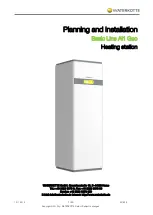
GALA PULSE SYNERGIC DR ADVANCED. Instructions Manual
65
Due to the increase in temperature absorbed by the torch, as during the pulsed arc welding its heating temperature
increases, it is recommended to continuously cool the welding torch, thus reducing the use of consumables, faults
and downtimes.
Likewise we must bear in mind the thermal diffusion of the torch consumables, as if the temperatures increases, this
will cause an increase in dilation, which will generate greater contraction on cooling. This will slow down the wire
feeding when it passes through the contact tip.
Excess pressure on the wire feeding rollers will be harmful for the system as we run the risk of squashing the wire,
increasing its diameter in one of its axes and increasing the resistance in the liner. It will also, cause of variation in
the feed uniformity, changing one of the essential arc parameters, the wire speed.
DOUBLE ARC WELDING
The dual pulsed arc welding system is recommended to execute welding beads that need to have a very good
aesthetic aspect. Especially indicated for aluminium alloy joints, where we require a more controlled heat input,
obtaining more even beads.
This work mode enables the user to achieve welding with more marked surface aspect, and it is optimal for
automated or robotised applications, where the movement speed and the height of the torch are constant features.
ALUMINIUM WELDING
The dynamic behaviour of the aluminium presents greater arc stability than in steel, which is the result of the use of
100% Argon as shielding gas, which facilitates the arc transmission.
With respect to the differences between magnesium and silicon alloys, we can observe an increase in malleability in
alloys with silicon, which may generate greater feed problems.
Due to the increase in temperature absorbed by the torch during pulsed arc welding, certain feed limitations in its
use arise. The welding torch should be continuously cooled.
Furthermore, due to the typical feed limitations of the material, aluminium is highly malleable, so the use of torches
that are as short as possible is recommended (2-3 m).
The most critical point when welding aluminium is at the exit from the rollers, as from this point, the wire is submitted
to compression, meaning that it can easily roll up bend, or break.
It is recommendable to try to reduce the friction produced by the wire to a minimum to try to achieve a quality feed.
To this end we can carry out the following adjustments:
1.
Firstly, we must talk about cleanliness. The wires must be free from dust, grease, impurities and humidity. The
metal dust adheres easily to the wire on the aluminium reels, and may even saturate the liner of the torch giving
rise to the appearance of problems. To prevent this, the feed system must be cleaned regularly maintaining the
wire in the conditions recommended by the manufacturer.
2.
Use different diameter fillers, whenever possible, to reduce the derived wire feeding problems.
3.
Use of Push-Pull torches. They include a feed system in the torch casing, which is synchronised with that of the
equipment, so that a coordinated "push and feed" job is carried out minimising the feed problems. The use of
this type of torch is recommended for lengths of over 6 m.
4.
Reduce the actual torch resistance: Reducing its length, the neck shape (the straighter the better) or replacing the
liner with graphite or Teflon.
5.
Use of "U" feed rollers and verification of the state of the pressure rollers, which with use, may suffer wear and
generate feed problems (example: the wire slips].
6.
Excessive pressure of the clamping knob will be harmful for the system as we run the risk of squashing the wire,
increasing its diameter in one of these axes and increasing the resistance on the liner.
We must adjust the liner to the diameter of the wire used in the welding and decrease the distance between the exit
from the roller and the liner. (Example: if this distance is great, the wire bends and breaks).
















































